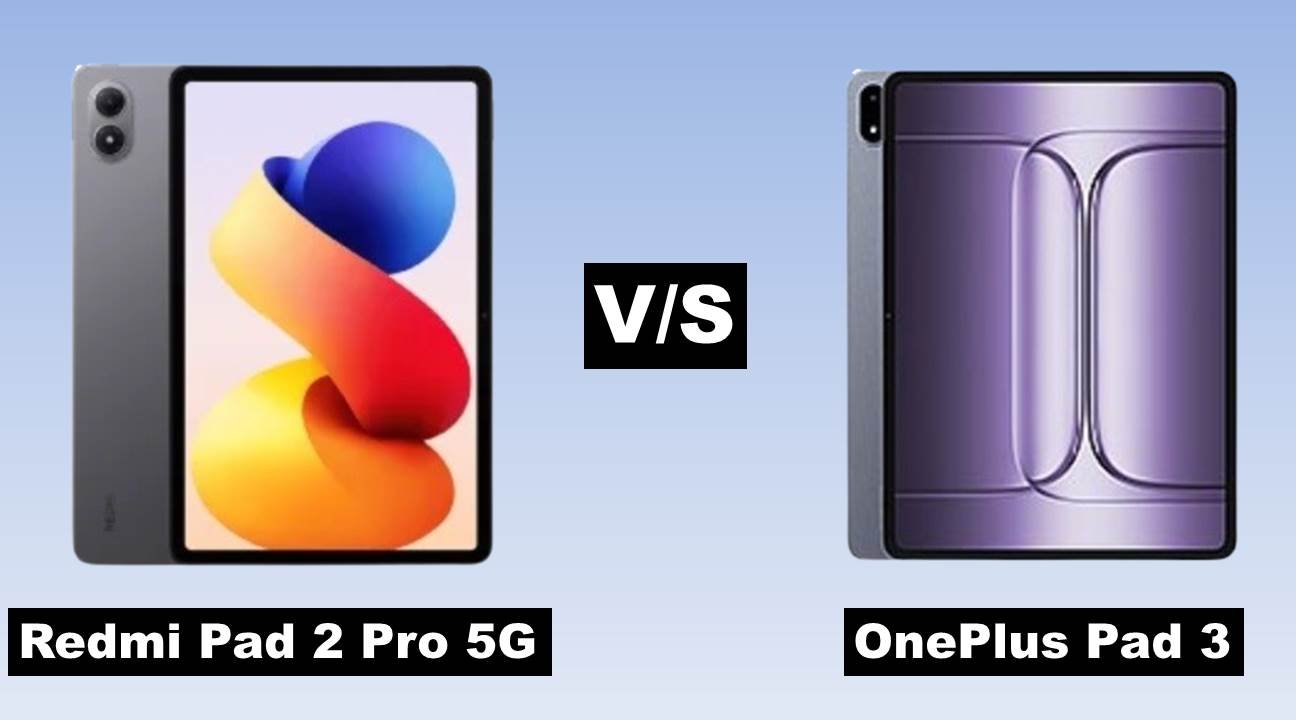
The tablet market in 2025 is heating up, with brands like Xiaomi’s Redmi and OnePlus stepping up their game to deliver devices that cater to both casual users and professionals. Two of the most talked-about models right now are the Redmi Pad 2 Pro 5G and the OnePlus Pad 3. While both tablets bring premium features, they target slightly different audiences. Let’s break down their differences across design, display, performance, battery, and more to see which one deserves your money.
Both tablets boast premium glass and aluminum construction, giving them a sleek and modern feel. The Redmi Pad 2 Pro 5G is slimmer and lighter, making it an excellent option for those who prioritize portability. It also comes with an optional matte glass finish, which adds scratch resistance and boosts durability. On the other hand, the OnePlus Pad 3 takes a more immersive approach with ultra-thin bezels, but it sacrifices some portability in exchange.
Verdict: OnePlus Pad 3 is best for an immersive design, while Redmi Pad 2 Pro 5G wins on portability.
The OnePlus Pad 3 shines with a larger 13.2-inch panel that offers a 144Hz refresh rate and 900 nits brightness, making it perfect for gamers and HDR content lovers. The Redmi Pad 2 Pro 5G sticks to a 12.1-inch screen with a 120Hz refresh rate and 600 nits brightness. It’s smooth enough for everyday tasks but not as vibrant. Both support stylus input, though OnePlus provides a more responsive experience.
Verdict: OnePlus Pad 3 delivers a superior screen, while Redmi Pad 2 Pro 5G remains practical for everyday viewing.
Under the hood, the OnePlus Pad 3 packs the Snapdragon 8 Elite, making it a powerhouse for gaming, creative apps, and multitasking. It also uses UFS 4.0 storage, ensuring blazing-fast read/write speeds. The Redmi Pad 2 Pro 5G runs on the Snapdragon 7s Gen 4, which is more than capable for browsing, media, and light multitasking. Plus, it offers microSD card support, which OnePlus lacks.
Verdict: OnePlus Pad 3 is perfect for power users; Redmi Pad 2 Pro 5G balances performance with expandability.
Both tablets run on Android 15, but software optimization makes a big difference. The OnePlus Pad 3, with ColorOS enhancements, offers smoother multitasking and stronger ecosystem integration—especially for those already in the OnePlus ecosystem. Meanwhile, the Redmi Pad 2 Pro 5G, running HyperOS 2, keeps things simple and straightforward.
Verdict: OnePlus Pad 3 excels in ecosystem and long-term support, while Redmi Pad 2 Pro 5G is ideal for basic users.
For cameras, both tablets have 8MP front cameras suitable for video calls. However, the OnePlus Pad 3 pulls ahead with a 13MP rear camera featuring gyro-EIS for smoother videos. When it comes to audio, Redmi includes four speakers, while OnePlus doubles that to eight speakers, creating a more immersive soundscape.
Verdict: OnePlus Pad 3 takes the lead in both audio and camera performance.
The OnePlus Pad 3 supports Wi-Fi 7, ensuring faster connectivity, while the Redmi Pad 2 Pro 5G comes with Wi-Fi 6. Both feature Bluetooth 5.4, but neither includes GPS or NFC. Storage expandability is where Redmi shines with microSD support, something OnePlus skips.
Verdict: OnePlus Pad 3 leads in wireless speed, Redmi Pad 2 Pro 5G offers flexibility with expandable storage.
Both tablets support stylus and keyboard accessories, but the experience differs. The Redmi Pad 2 Pro 5G appeals to students with its magnetic stylus support and handy 3.5mm headphone jack. In contrast, the OnePlus Pad 3 is better tailored for professionals, thanks to its larger display and more advanced stylus support for creative workflows.
Verdict: OnePlus Pad 3 is productivity-focused; Redmi Pad 2 Pro 5G suits casual note-taking and student use.
The Redmi Pad 2 Pro 5G houses a massive 12,000 mAh battery with 33W charging and reverse charging capability. The OnePlus Pad 3 also packs a 12,140 mAh battery, but it recharges much faster with 80W wired charging. While OnePlus leads in speed, Redmi’s mid-range chipset is more power-efficient.
Verdict: OnePlus Pad 3 charges faster, Redmi Pad 2 Pro 5G lasts longer with efficiency.
Perhaps the most significant difference is price. The Redmi Pad 2 Pro 5G starts at $300, making it a budget-friendly choice for students, casual media users, and light multitaskers. The OnePlus Pad 3, priced at $600, doubles the cost but justifies it with top-tier hardware and premium features.
Verdict: Redmi Pad 2 Pro 5G is unbeatable in budget value, while OnePlus Pad 3 is the right pick for professionals and power users.
Choosing between the two depends on your needs. The OnePlus Pad 3 is the ultimate choice for professionals, gamers, and creators who need power, speed, and premium productivity features. On the other hand, the Redmi Pad 2 Pro 5G is a fantastic deal for students, casual users, and anyone looking for a well-rounded tablet without breaking the bank.
Comments